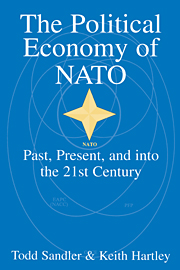Book contents
- Frontmatter
- Contents
- List of tables and figures
- Preface
- 1 NATO at the crossroads: An introduction
- 2 NATO burden sharing and related issues
- 3 On NATO expansion
- 4 NATO and peacekeeping
- 5 NATO and the defense industrial base: EU and USA
- 6 NATO challenges on the horizon
- 7 NATO and Europe
- 8 NATO design
- 9 Conclusions and future scenarios
- References
- Author index
- Subject index
8 - NATO design
Published online by Cambridge University Press: 05 June 2012
- Frontmatter
- Contents
- List of tables and figures
- Preface
- 1 NATO at the crossroads: An introduction
- 2 NATO burden sharing and related issues
- 3 On NATO expansion
- 4 NATO and peacekeeping
- 5 NATO and the defense industrial base: EU and USA
- 6 NATO challenges on the horizon
- 7 NATO and Europe
- 8 NATO design
- 9 Conclusions and future scenarios
- References
- Author index
- Subject index
Summary
A little-explored issue concerns the design of NATO in terms of the appropriate form of the linkages among allies and the proper organizational structure within NATO itself. The new institutional economics can, however, provide the conceptual framework for an examination of the architecture of NATO based on transaction costs and benefits considerations. Allies belong to NATO because they perceive there to be a net gain from remaining members, despite expenses associated with membership. Article 13 of the North Atlantic Treaty allows any ally to leave the alliance after giving a year's notice, while Article 10 permits other European states to join the alliance if invited (see Chapters 2 and 3). If the alliance is to remain viable, then a proper institutional structure must exist to give the overall membership the greatest possible net gains, while ensuring that each ally also perceives a net advantage over the best nonmembership alternatives. Moreover, the alliance structure must be adjusted over time to respond to developments that alter the configuration of transaction costs and benefits associated with alliance membership. Recent noteworthy changes concerning strategic doctrine, alliance size, and weapon technology may affect the patterns of transaction costs and benefits derived from NATO, and, in so doing, may require changes in the linkage form among allies as well as in NATO's organizational structure.
With its current linkage structure, NATO is best described as a loose organization in which allies' autonomy is maintained in large part (Sandier, Cauley, and Tschirhart, 1983; Sandier and Forbes, 1980).
- Type
- Chapter
- Information
- The Political Economy of NATOPast, Present and into the 21st Century, pp. 223 - 248Publisher: Cambridge University PressPrint publication year: 1999



